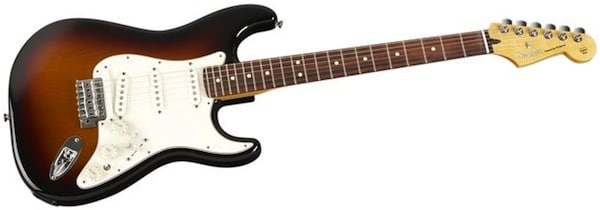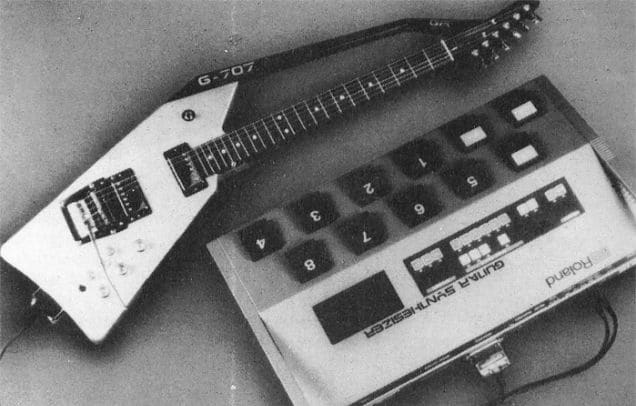Last Updated on August 2, 2022 by IDS Team
If you choose to go from playing guitar to using synths in your music, you may think at first that it is a big step. Nevertheless, some similarities between guitar playing and synthesis make synthesis for guitarists much easier. Read on to find out more about these and how you can use them in your own work. This is especially true if you are investigating using synthesis in sound design for the first time.
Synthesis for guitarists is different to synthesis for other musicians. It is a lot easier to go to synthesis from programming beats than it is from playing guitar.. The reason why? When playing guitar, the musician affects tone and timbre with their fingers. Whilst guitar still involves adjusting knobs, there is much more control over tone simply by the guitarist handling the strings. However, guitarists can adapt to synthesis more easily by following a few simple tips. With these, you can easily create the same kind of feeling as your favourite Fender or Gibson.
Synthesis for guitarists: Find Your Tone
As a guitarist, it is likely you pay attention to tone. Tone is that hard to pin down quality which can make the difference between good and bad guitar playing. It is as much about the guitarist themselves as it is about the instrument. Many factors affect tone, from temperature, to air pressure, and the age of the guitar itself. With both analogue and digital synthesis, the musician will gain more control over tone and can remove this random variability.
With synthesis, musicians truly sculpt the exact tone they like, allowing for precision control. This includes variables such as timbre, richness, and depth. However, guitarists who are used to having tone come naturally can find it difficult to adjust. You might find it frustrating to get into the building blocks of sound – especially when you aren’t able to pin down those random, ephemeral moments you get when playing guitar.. Nevertheless, if you find a tone you like and memorise how to achieve it on your synth, everything will go much more smoothly.
Synthesis for guitarists: Choose Your Synth Wisely
For a guitarist, some of the best synths to start off with are analogue synths. This is because they mimic the rich tone you would find on a guitar. Small, portable, and easy-to-use classic analogue synths such as one of the ones by Korg are a good choice for a guitarist who is new to synthesis.
Four brilliant beginner analogue synths for guitarists (and one FM synthesizer)
- Korg Monologue – The monologue is easy to use, does what it says on the tin, and focusses on lead lines. This monophonic synth is an easy transition to synthesis for guitarists. https://www.korg.com/uk/products/synthesizers/monologue/
- Moog Minitaur – As one of the cheaper synths from a classic band, this is a bass synth but uses transferrable skills. The Moog Minitaur will give you the opportunity to play with big fat sounds which you can’t achieve on guitar as well. It this plus it’s other features which make it it a welcome addition to what you may be doing already. https://www.moogmusic.com/products/minitaur
- Korg Microkorg – The Microkorg is another fantastic, small, and portable synth from Korg. The hands on nature and simplicity of this synth makes it ideal for transitioning guitarists. https://www.korg.com/uk/products/synthesizers/microkorg/ It also doubles as a vocoder.
- Arturia Microfreak Hybrid Synth – As a hybrid synth, this uses a cross between analogue and digital technologies. The Microfreak is a perfect easy way to get used to the basics of synthesis for either of them. https://www.arturia.com/products/hardware-synths/microfreak/overview
- Elektron Model:Cycles 6-track FM Synth and Groovebox – a small, easy to use synth which creates sounds which are fantastic for solos or riffs. These have much more space-age, ethereal possibilities than analogue synthesis. https://www.elektron.se/jp/modelcycles-explorer
Learn How Synthesis Works from Scratch
If you learn how sound works from the bottom up, you will be able to truly understand your synth. This means you will not only learn how it works, but how music works as a whole. As a result, the learning process will come quicker. You will be able to sculpt sounds to your liking whilst understanding where, how, and why they differ from the guitar.
Try getting technical with your guitar too. Learn exactly how to affect it’s sound with the subtlest things you do, and you will find that you can craft noise more easily. If you understand the roots of music as a whole, you can transfer these skills to almost any instrument. In addition, by specifically learning the details of your exact model of synth, you will become more in tune with it. Synths can have staggering differences between models and each of these inevitably has it’s own characteristics.

Synthesis for guitarists: Find your Flow
Every musician has to find their flow. Neuroscientists identify as the state in which you are playing and time appears to speed up or stand still. This happens as a result of the way music slightly alters the brainwaves. Guitarists who prefer to hold an instrument in their hands might struggle at first to achieve flow with a synth. However, when they learn how synthesis works can quickly program sounds without having to stop and get technical. Then, it is as easy to reach a creative state of mind with your synth as it is with your guitar. The only difference is that your flow state when playing synth may be a little bit different.
Make it Apply to Your Guitar Playing
Synthesis not only creates new sounds but mimics those which already exist. Lead lines and guitar solos are exactly the types of playing which translate really well to synthesis. As a result, an easy way to master a synth is to transfer some of your favourite riffs or soloing patterns to it. Therefore you will see the similarities, differences, and connections between the two instruments. Once you master this, you will be able to move more easily between them.
Synthesis for guitarists: Final Thoughts
Making the transition from guitar to synthesis is as simple as learning their similarities and differences. This means you can avoid too much technical detail, while still understanding how to make sound. At a deeper level, synthesis for guitarists allows you to design textures and timbres beyond those of the guitar. Knowing what sounds you want first is also very important. Once you do, you will find that synthisers can produce sounds which are strikingly similar yet give you have the freedom to craft your own forms of noise. This is a popular and creative way of producing riffs for both instruments. Therefore, knowing where you’re starting and where you want to end up before you move on to anything more synth-specific means you will have the best of both worlds.
If you enjoyed this post on Music Hardware, we recommend you check the full Music Hardware category by clicking here.



